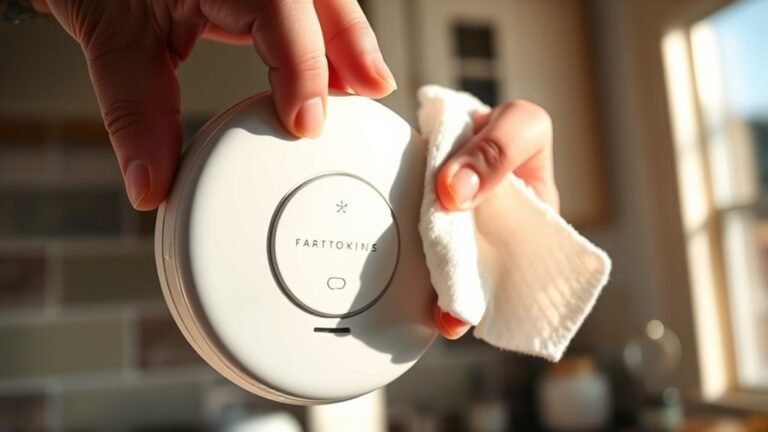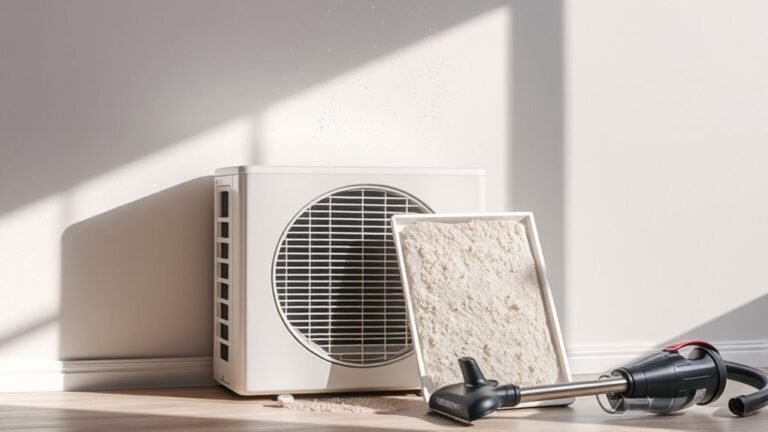Common Mistakes When Cleaning Dryer
When cleaning your dryer, don’t skip the lint trap—it’s key for efficiency and safety. Avoid harsh chemicals that can damage components; stick to mild soaps instead. Many overlook vent and ductwork maintenance, which can cause blockages and fire risks. Inspect the drum and seals regularly to prevent heat loss and wear. Always unplug before cleaning and use minimal moisture to protect electrical parts. Keep going for tips that help you clean smarter and safer.
Neglecting to Clean the Lint Trap Regularly

Although it might seem like a small step, neglecting to clean the lint trap regularly can lead to serious problems. When lint buildup goes unchecked, it restricts airflow and forces your dryer to work harder, compromising dryer efficiency. You might think skipping this task saves time, but in reality, it costs you freedom—freedom from longer drying times, higher energy bills, and potential fire hazards. Keeping your lint trap clean guarantees your dryer runs smoothly, dries clothes faster, and uses less energy. It’s a simple habit that protects your home and grants you more time to enjoy what matters. Don’t let lint buildup hold you back; make cleaning the lint trap a regular part of your routine to maintain peak dryer efficiency and peace of mind.
Using Harsh Chemicals on Dryer Components
If you want to keep your dryer in good shape, steer clear of harsh chemicals on its components. Using strong cleaners can damage surfaces, degrade seals, and even void warranties. Prioritize chemical safety by opting for mild detergents or specialized dryer maintenance products designed for your appliance.
Here’s a quick guide to what you should and shouldn’t use:
| Component | Safe Cleaner | Harsh Chemicals to Avoid |
|---|---|---|
| Drum | Mild soap, vinegar | Bleach, ammonia |
| Exterior | Soft cloth, gentle detergent | Solvents, abrasive cleaners |
| Lint Trap | Warm water, mild soap | Strong degreasers |
Ignoring the Dryer Vent and Ductwork

You might overlook your dryer vent and ductwork, but ignoring them can cause serious blockages that risk fires. Regular duct cleaning is essential to keep airflow clear and your dryer running safely. Make sure you maintain the vent properly to avoid costly repairs and hazards.
Vent Blockage Risks
Neglecting your dryer vent and ductwork can create serious blockage risks that not only reduce efficiency but also pose fire hazards. When lint and debris build up, they restrict airflow efficiency, making your dryer work harder and longer. This not only wastes energy but also increases wear and tear, limiting your freedom from frequent repairs. More importantly, blocked vents can trap heat, creating a dangerous environment that compromises vent safety and can ignite fires. By keeping your vent and ductwork clear, you guarantee smooth airflow, protect your home, and extend your dryer’s lifespan. Don’t let a simple blockage chain you down—staying on top of vent maintenance frees you from risks and keeps your laundry routine running safely and smoothly.
Duct Cleaning Frequency
Blocked vents aren’t just a one-time issue—they can build up again quickly without regular attention. That’s why understanding the duct cleaning importance is essential if you want your dryer to run efficiently and safely. Skipping or delaying cleaning means you risk lint accumulation, reduced airflow, and potential fire hazards. To keep your freedom from unexpected breakdowns, set a consistent cleaning schedule for your dryer ductwork. Most experts recommend checking and cleaning your ducts at least once a year, but if you use your dryer heavily, more frequent cleaning might be necessary. Don’t ignore your dryer vent and ductwork—staying on top of duct cleaning guarantees you keep your laundry routine smooth and your home safe without unnecessary interruptions.
Proper Vent Maintenance
Although it might seem like a minor task, ignoring your dryer vent and ductwork can lead to serious problems over time. Proper vent maintenance is essential not only for your dryer’s efficiency but also for your safety. Lint buildup can cause blockages, increasing fire risk and reducing airflow. You want your dryer to work smoothly without wasting energy, right? Ensuring proper installation of your vent system is just as important—poorly installed ducts can trap moisture and lint, leading to mold or damage. Regularly check and clean the vent to keep everything running freely. Taking these simple steps gives you the freedom from costly repairs and hazards, letting your dryer breathe easy and your laundry routine stay hassle-free. Don’t overlook the vent maintenance importance!
Overlooking the Dryer Drum and Seals

Even if you regularly clean your dryer’s lint trap, you might still miss the drum and seals, which can collect dirt and residue over time. Neglecting drum maintenance not only reduces efficiency but can also cause clothes to snag or wear prematurely. Taking a moment to inspect these areas frees you from unexpected damage and keeps your dryer running smoothly. Seal inspection is equally important; worn or cracked seals let heat escape, increasing drying time and energy costs. By paying attention to these often-overlooked parts, you maintain your dryer’s performance and extend its lifespan. Don’t let dirt or damaged seals hold you back—keep your dryer in top shape by including the drum and seals in your regular cleaning routine.
Not Unplugging the Dryer Before Cleaning
Before you start cleaning your dryer, you should always unplug it to avoid electrical hazards. It might seem like a small step, but skipping this safety precaution can lead to serious risks. When the dryer is still connected to power, even a simple touch inside can cause shocks or short circuits. You want your cleaning routine to be free and worry-free, not constrained by accidents or injuries.
Taking this one simple safety precaution guarantees that you can work confidently without the danger of electrical hazards hanging over you. Unplugging is quick, easy, and protects both you and your appliance. Don’t rush past this step—embrace the freedom that comes with knowing you’re safe while maintaining your dryer.
Using Excessive Water or Moisture During Cleaning
If you use too much water or moisture when cleaning your dryer, you risk damaging its electrical components and causing rust. You want to enjoy your freedom without worrying about water damage or costly repairs. That’s why moisture control is essential during your cleaning routine. Instead of pouring water directly, opt for a damp cloth to wipe surfaces gently. Avoid spraying water near vents, wiring, or the drum. Excess moisture not only invites rust but can also short-circuit parts, leaving you grounded longer than necessary. Keep your cleaning simple and dry, focusing on removing lint and debris without soaking your appliance. By managing moisture carefully, you protect your dryer’s longevity and keep your laundry routine hassle-free and free-spirited.
Frequently Asked Questions
How Often Should I Replace My Dryer’s Lint Trap?
You should replace your dryer’s lint trap whenever it shows signs of wear or damage to keep lint trap maintenance effective. Regularly inspecting it helps maintain dryer efficiency, ensuring your clothes dry quicker and your energy bills stay low. If the screen tears or gets clogged beyond cleaning, it’s time for a new one. Staying on top of this lets you enjoy the freedom of hassle-free laundry days.
Can Dryer Sheets Cause Buildup Inside the Dryer?
Yes, dryer sheets can cause dryer sheet buildup inside your dryer. The fabric softener residue they leave behind can accumulate on the lint trap, drum, and vents, reducing your dryer’s efficiency. If you want to keep your dryer running freely, it’s a good idea to clean these areas regularly and consider alternatives like wool dryer balls. That way, you avoid buildup and keep your clothes feeling fresh without any hassle.
What Are the Signs of a Malfunctioning Dryer Thermostat?
Think of your dryer’s thermostat as the guardian of warmth, keeping the balance just right. When you notice thermostat symptoms like erratic temperature fluctuations or your clothes coming out too damp or scorched, it’s a signal the guardian’s lost control. You might feel the freedom of a quick dry slipping away, replaced by longer cycles or overheating. Trust these signs—they’re your cue to check or replace the thermostat to restore your dryer’s harmony.
Is It Safe to Clean the Dryer Drum With Vinegar?
Yes, it’s safe to clean the dryer drum with vinegar! Vinegar benefits you by cutting through grime and deodorizing without harsh chemicals. When you use it for drum cleaning, you’re freeing yourself from stubborn residue and odors, keeping your dryer fresh and efficient. Just dilute vinegar with water, apply gently, and wipe down. You’ll enjoy a clean drum and the freedom of a natural, effective cleaner that’s easy on your appliance.
How Do I Know if My Dryer Vent Is Clogged?
Imagine you notice your clothes are taking forever to dry—that’s a classic sign of vent blockage. When airflow issues occur, your dryer struggles to push hot air out, making drying inefficient and risky. You might also feel your dryer getting unusually hot or see lint buildup around the vent. To stay free from hazards and keep things running smoothly, regularly check and clean your dryer vent to avoid these airflow problems.






